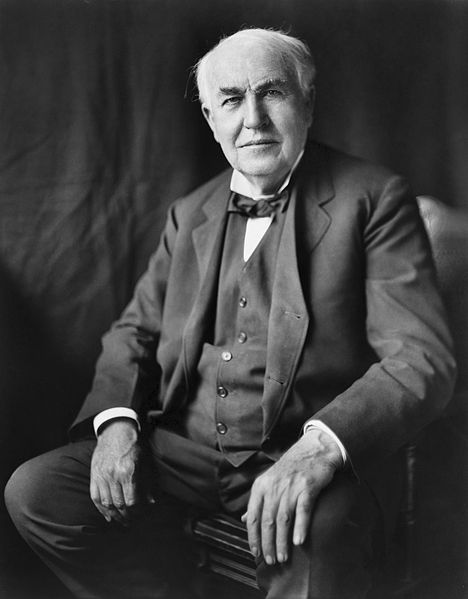Thomas Edison invented the phonograph and the motion picture camera and projector. He hoped they would revolutionize education.
Thomas Edison on Phonograph and Motion Picture Camera
The phonograph first suggested the motion picture camera. I had been working for several years on my experiments for recording and reproducing sounds, and the thought occurred to me that it should be possible to devise an apparatus to do for the eye what the phonograph was designed to do for the ear.
I had only one fact to guide me at all. This was the principle of optics, technically called “the persistence of vision,” which proves that the sensation of light lingers in the brain for anywhere from on-tenth to one-twentieth part of a. Second after the light itself has disappeared
Ptolemy, the Ancient Greek Mathematician, first demonstrated this truth by means of a wooden wheel, painted with spots of red paint. As the wheel was whirled swiftly around, the spots on its surface apparently melted together and gave the effect of one continuous red streak, although when the wheel had stopped it was seen the spots had not changed their positions at all.
Thomas Edison in “The Diary and Sundry Observations of Thomas Alva Edison” (1948)
 There were no real precursors for the phonograph. It was a radical innovation that unlocked a number of applications. The original foil cylinders could only record two minutes and were something of a novelty but others extended the invention shifting to the platter format in shellac and then vinyl that had longer recording times. Edison was able to market his 4 minute cylinders a way to capture dictation. But in an article in North American Review in June 1878 Edison offered several accurate forecasts of future uses of the phonograph: “books” for blind people, musical performances, capturing dictation of letters, capturing wills, and connection with a telephone to record messages.
There were no real precursors for the phonograph. It was a radical innovation that unlocked a number of applications. The original foil cylinders could only record two minutes and were something of a novelty but others extended the invention shifting to the platter format in shellac and then vinyl that had longer recording times. Edison was able to market his 4 minute cylinders a way to capture dictation. But in an article in North American Review in June 1878 Edison offered several accurate forecasts of future uses of the phonograph: “books” for blind people, musical performances, capturing dictation of letters, capturing wills, and connection with a telephone to record messages.
Eadward Muybridge captured a series of 12 photographs of a horse running on a racetrack in June 1878. His goal was to understand if at high speed all four of the horses legs left the ground at the same time, a motion to fast for the eye to follow. The result was surprising, all four legs left the ground at the same time, but in a “gather” position where they are all under the body of the horse and not extended forward and back has had been portrayed by many painters. The 12 photographs were put on a disk as slides and projected using and magic lantern to make one of the earliest movies.
“Do you know that one of my first thoughts for the motion picture camera was to combine it with the phonograph? My plan was to synchronize the camera and the phonograph so as to record sounds when the pictures were made, and reproduce the two in harmony. As a matter of fact, we did a lot of work along this line, and talking pictures were shown in many theaters in the United States and foreign countries.
[…] They are producing pictures of this kind now, I understand. We were working, of course, from an entirely different angle—but we had the first of the so-called “Taking Pictures” in our laboratory thirty years ago.”
Thomas Edison in “The Diary and Sundry Observations of Thomas Alva Edison” (1948)
Edison was motivated by the desire to invent and would produce his creations in small volumes but tended to move on to new ideas. His first major success was quadruplex telegraphy, which built on an earlier duplex breakthrough and allowed Western Union to send four messages in parallel (two in each direction) on the same wire.
“We might have developed them into a greater commercial circulation if we had kept on—but I was interested in the educational and not the entertainment field. When educators failed to respond I lost interest. What I had in mind was a bit ahead of the times, maybe. The world was not ready for the kind of education I had pictured.
Maybe I’m wrong, but I should say that in ten years textbooks as the principal medium of teaching will be as obsolete as the horse and carriage are now. I believe that in the next ten years visual education—the imparting of exact information through the motion picture camera—will b a matter of course in all of our schools. The printed lesson will be largely supplemental—not paramount.”
Thomas Edison in “The Diary and Sundry Observations of Thomas Alva Edison” (1948)
Reading Edison’s diary surprised me at how prescient he was about the potential applications of his inventions. It’s unfortunate how slow educational institutions have been in exploring new instructional modalities.
Related Blog Posts
- Q: How Do I Calculate Business Model Parameters For A Novel Product?
- Continuing Education In Entrepreneurship
- Education of a Wandering Man by Louis L’Amour
- Entrepreneurship’s Ups and Downs
- Newborns vs. a Startup’s First Product
- Texas Hold’Em as a Model for Technology Startups
- See What’s Missing: Careful Observation is Key to Success
Image Credit: from https://en.wikipedia.org/wiki/File:Thomas_Edison2.jpg in the public domain.
